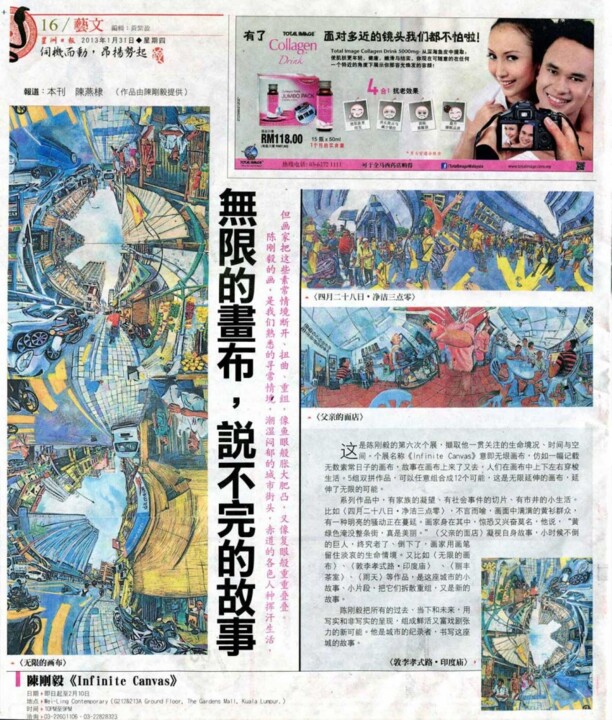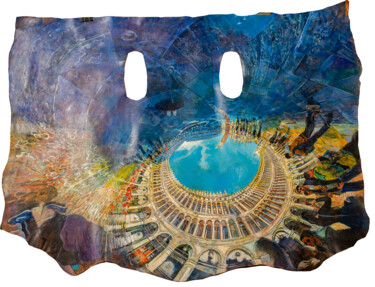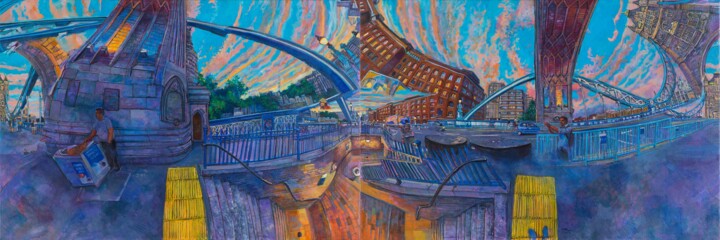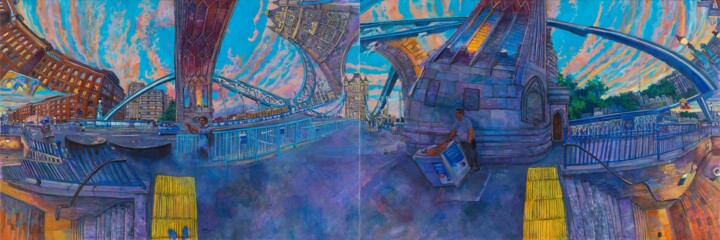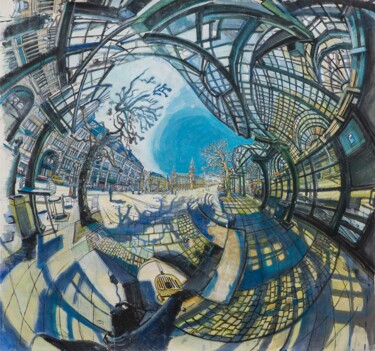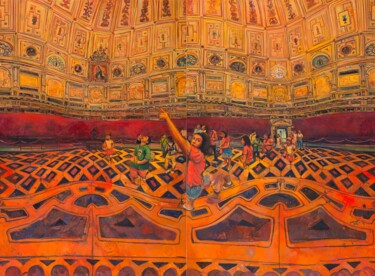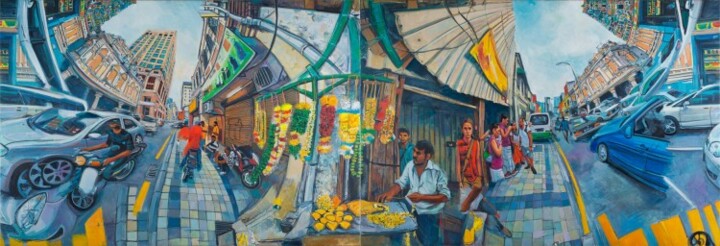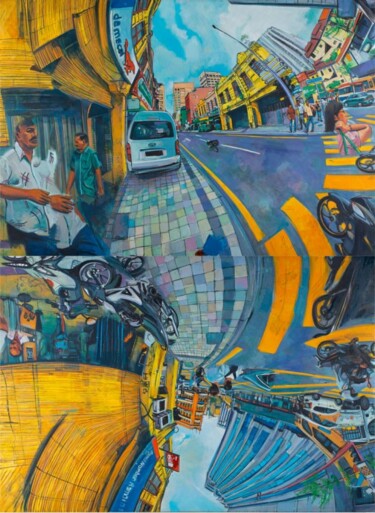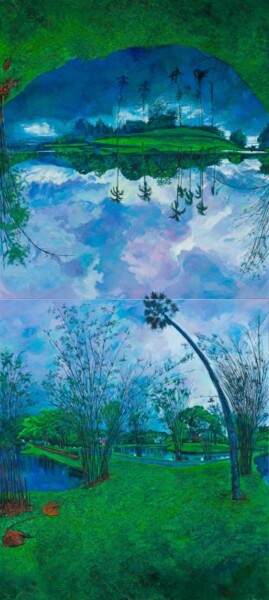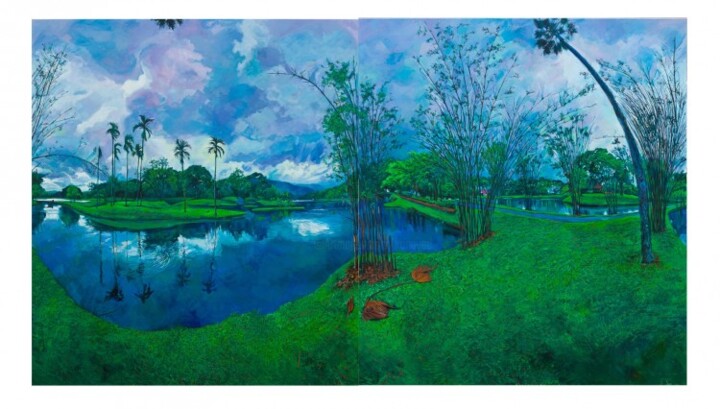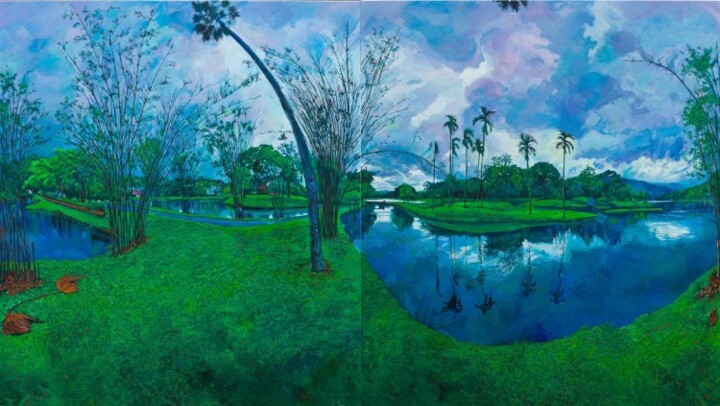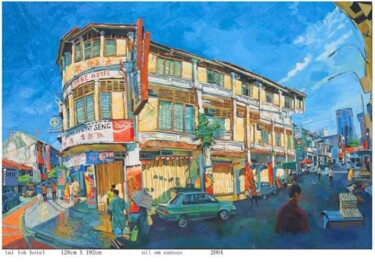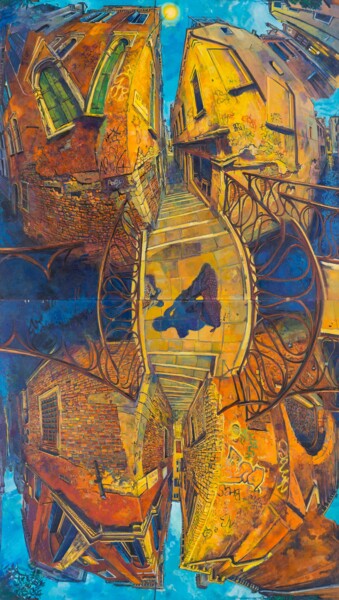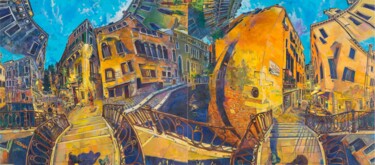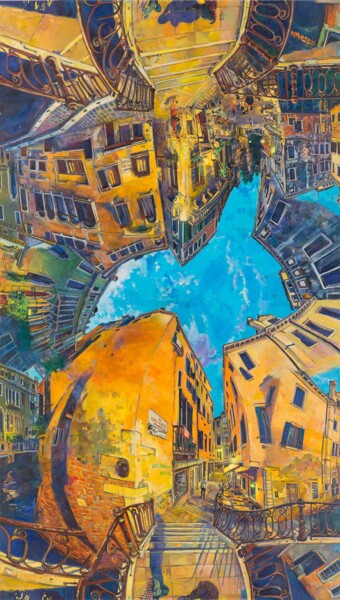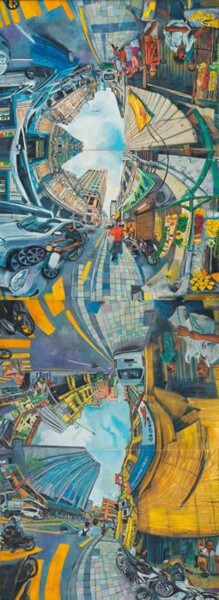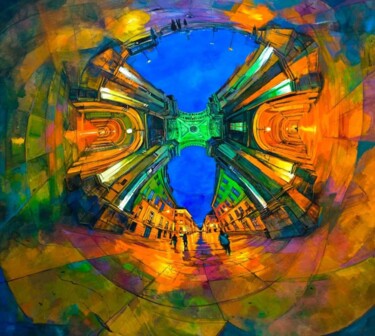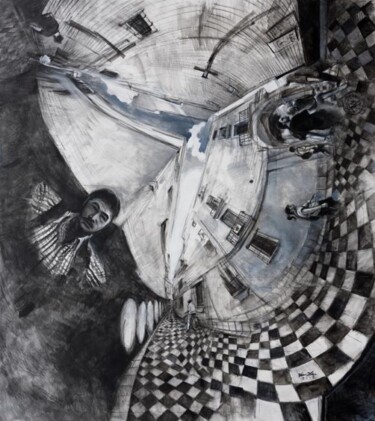Chin Kong Yee
Chin Kong Yee is a contemporary Malaysian artist. He has labeled his style as Actuality Accorded Painting (AAP), whereby, in painting and portraying an object, it has to have existed, and have undergone the process of being real, in order for it to be translated onto the canvas as Art. AAP, is basically the act of seeing-where the past, the present and the future is enveloped into one when one looks at an object. Once eye contact has been made through AAP, the images become the past.
Kong Yee’s works evoke a somewhat surreal feel about them. By combining the present, past and future through a depiction of two perspectives (realistic and unrealistic) his paintings have an exciting, dramatic edge about them that draws the viewer into his space.
Chin Kong Yee was born in 1973, in Malaysia, where he graduated from the Central Academy of Art. The large and detailed panoramas portrayed on Kong Yee's canvases have a significant audience of local and international collectors. His works can be found in numerous private and public collections such as The National Visual Arts Gallery, Shearn Delamore, Wong & Partners, The Aliya and Farouk Khan Collection, HSBC, Anika Insurance Brokers, and the United Overseas Bank.
Discover contemporary artworks by Chin Kong Yee, browse recent artworks and buy online. Categories: contemporary malaysian artists. Artistic domains: Painting, Photography. Account type: Artist , member since 2002 (Country of origin Malaysia). Buy Chin Kong Yee's latest works on ArtMajeur: Discover great art by contemporary artist Chin Kong Yee. Browse artworks, buy original art or high end prints.

Artist Value, Biography, Artist's studio:
#tomorrow • 11 artworks
View allIn November 2019, Venice suffered its worst high tide in 50 years. Over 80% of the city was submerged by water, and residents had to flood-proof and barricade their homes and businesses. Many houses, hotels, and restaurants were destroyed. This phenomenon coincided with the Venice Art Biennale 2019, and as a result, some National Pavilions had to close their doors to visitors. Chin Kong Yee found himself in the middle of this situation, being in Venice to carry out his performative work, which saw him walking into the various exhibitions in his wearable painting.
As a painter and a traveler, Kong Yee puts himself in the position of an observer when going to a place, rather than merely visiting as a tourist. Instead of avoiding the flood, he put on a pair of waterproof boots, and continued immersing himself in the city, one that he has always been fascinated and moved by. He recalls, “After the deafening alarm noise to warn us of the water rise, there’s always a peaceful silence”. It was to his surprise that upon returning to Malaysia, he experienced a flash flood that affected his own house. With these incidents taking place one after another, it became clear to him that if we do not come together and channel our efforts towards addressing this pressing situation, our lands will gradually sink and disappear.
Since 2019, he has also been experimenting with the idea of ‘wearable art’, in which he would cut and stitch pieces of the leather based on a pattern before painting on its surface, enabling his paintings to be worn. His signature style of adopting a fish-eye lens perspective and combining the past, present, and future through his “Actually Accorded Painting” (AAP) technique, is yet again present in these recent paintings. The concept of presenting the past, present, and future is also reflected through the different periods of time that are presented through this exhibition, in relation to the pandemic. To a true traveller like Kong Yee, the experience of staying at home for the past 20 months was life changing. Isolated throughout the lockdown, he took himself back to the feeling of being surrounded by people, through 360-degree paintings of market scenes such as Pasar Seni (20192021) and Pasar Ubud - Bali (2014), as well as the night scenery of Venice. Consisting of two interchangeable panels, Summer Night in Venice (2021) allows multiple display arrangements; a technique that he started developing in 2010.
Dancing with Shadows • 26 artworks
View allKnown for his unique fish eye painting composition; Chin Kong Yee morphs the past, present and future into one infinite image. The artist depicts the idea of time as a surreal ideology as though we are constantly in a state of change yet staticity, an eternal loop. Prompting viewers to question the very meaning of time.
As an artist, Chin Kong Yee has evolved and transcended his art from a simple fish eye lens composition (seen in his ‘(eye)-llusions’ series) into pivoted on axis, whereby the work can be rotated 360 degree (seen in his ‘Infinite Canvas – Kuala Lumpur’ and ‘The Flower’ series) and finally into interchangeable art pieces. He has established his own personal painting style ‘Actuality Accorded Painting’ (AAP) that captures the image in the present, as though the viewer were to experience it the moment themselves, rather than observing a static image from the past. The progression of his work runs parallel to his progression as an artist in delivering this visual message of an abiding world.
Working with a style filled with intense dynamism, distortion and unique composition, viewers are inevitably pulled into his works as though they were to enter a different, surreal and timeless reality. Evoking this sense of immortality and invisibility. In ‘Dancing with Shadows’ Chin Kong Yee explores this very notion through his depiction of different European cities such as London and Venice.
Upon his third revisit to Venice, a city that at first left him lost and alone with the foreign scape and shadows of the night. He found himself sitting in Piazza San Marco, where he was taken back 12 years ago. The city was left frozen; the music, the moon and the scene all remained unchanged from a decade earlier. With only his own age and presence acting as an indicator to distinguish the change of time, he found him self in this surreal, timeless and infinite realm.
Inspired by this time-conflicting and surreal experience in Venice, Chin Kong Yee developed his visual narration of time through a series of oil paintings with a strong emphasis on shadows. These paintings are considered interchangeable as they can be organised in multiple different combinations in order to reflect the ever changing and evolving yet static entity of time.
Dancing with Shadows will be showing from 9th August to 2nd September 2018 at Wei-Ling Contemporary.
The Flower • 12 artworks
View allThere are a couple of facets to the enjoyment of Chin Kong Yee’s works. First, and the most evident, is the visual pleasure that his paintings bring. Saccharine yellows flirt with lush cobalt blues on the canvas, and swirling landscapes send the eyes on a kaleidoscopic viewing journey that has become the artist’s signature offering. Less obvious, though, are the subtle nuances that make up each work. There are the personal tales and precise moments in time when the scene was captured, and philosophical musings that simmer beneath the surfaces. So, despite their seemingly benign facades, Kong Yee’s works are complex creatures. And the artist, a critical filter of life.
The artist’s latest body of work comprises ten paintings, and understanding them means to trace aspects of Kong Yee’s career. For one, we need to note how his painterly style hinges greatly on European painting legacies, and how his use of photographic tools throws his practice into more recent times. Duomo Florence is a vivid expression of this marriage. In the work, the great Florentine cathedral takes centre stage and is flanked by two gravity-defying buildings that threaten to topple upon it. Such fish-eye twists to perspective have come to define Kong Yee’s works. And, the irony in this particular composition lies in the fact that Florence is the reputed birthplace of linear perspective; Masaccio’s early Renaissance painting, Holy Trinity, can be found at the city’s Santa Maria Novella church, and it takes podium place for its use of this spatial rule – the very one that Kong Yee flouts in his art.
But it’s not just Occidental traditions that we can reference in Kong Yee’s latest works. A relatively new addition to the artist’s opus is the use of traditional xuan paper and Chinese calligraphy, as seen in Tia Garden & Chinese Calligraphy. Based on his own experiences in Berlin’s sprawling inner-city park, Tiergarten, the work features an autumnal-coloured patch with thousands of Chinese characters written in ink. This specific element pays homage to the complexities of Chinese script and how repetitions in the thousands are necessary to achieve levels of mastery. Musing on this, Kong Yee pokes fun at life’s challenges and confesses to his own unique brand of coping. “Life is 3D, written (forms) are 2D, but once read, it becomes 4D. So, I make it unreadable,” he says, referring to the work’s bed of Chinese characters and his own struggles learning German during his one-month stint in the capital city.
It’s this errant humour that characterizes the artist’s approach. And, during the course of our discussion on The Flower, the artist makes a joke about the socially-demanded linearity of thoughts and how manmade environments are all crafted along straight lines. Funny, he observes, pointing out rightly that the earth is round. This could explain why Kong Yee’s horizontal panoramas of yore now reappear within more compact formats and circular guises, and how increasingly, the artist has shifted from atmospheric portrayals to detailed inspections. Indeed, there are introspective, zen-like qualities to works like the verdant Forest, or the eponymous painting The Flower. “Everything only happens in the present,” says Kong Yee, drawing not-so-subtle hints to Buddhist teachings, and how the entire exhibition symbolizes the fact that the blooming of a flower is contained within a single moment and cannot be recaptured or repeated in its exactness. Could we not say the same of the ephemeral moments of life that Kong Yee captures in his works?
The two Dresden in Blue paintings illustrate this point, with both works showcasing rich blue light that could only have resulted from specific temperatures and other atmospheric conditions. Or, in U Turn, where a small group of people seem to march their bicycles out of one side of the painting and where a moving bicycle seems to spring forth from the opposite side. This decisive, unrepeatable moment – the photographic punctum or punctuation, as described by Henri Cartier-Bresson – is exactly what Kong Yee captures in his works, and like a flower that blooms, each scene is a compression of thousands of moments, stories, and elements rolled into one. Kong Yee’s compositions are anything but linear.
There’s some logic then, in Kong Yee’s adoption of the Golden Ratio. A mathematical principle that constitutes two rectangular shapes and a golden spiral, Kong Yee uses its principles to lay out the formal properties of all the works in this series. The Flower displays the golden spiral clearly, and so does Orange Flower, a portrayal of a vaulted church ceiling that curls upon itself and which seems to be doused in a glowing, golden-orange bath of light. These two accompanying works are regal and beatific, and the level of accuracy in the architectural detail is only accentuated by the artist’s investment in every other aspect of the subject matter; Kong Yee wasn’t just concerned with the physical spaces of the churches in these two works, but also researched other ecclesiastical aspects, such as the type of music they play in churches and how it affects people’s moods.
Kong Yee’s works lack aural properties, of course, but the artist certainly aims to encapsulate as many sensorial experiences into his works as he can. Indeed, Kong Yee presents a very keen and observant view of the world. He always has, and as an artist, plays the role of a ‘fly on the wall’ and a secret eye on the streets. With years of experience charting life unravelling before him, he has developed highly-tuned sensitivities to the temperaments of the weather, how these may have an effect on people’s moods, and even considers real-world developments like the fluctuating oil prices, headlines that inevitably seep beneath the conscious human skin. In many ways, he ruminates all of this to try to bring us back to the very moment when the flower first ‘bloomed’ before his eyes.
Though not exhibited with the rest of The Flower works in the exhibition, Kong Yee’s painting of Busan is his favourite in the series. It’s where the sky is at its most evocative, spreading steel-grey swathes across the sky, and where Kong Yee channels his artistic language through the waves swirling in curly lines across the canvas and the plays of ink that pay homage to classic Chinese ink paintings. The work seems to hint that our possibilities are endless, and maybe they are. The elasticity of time is mentioned several times by the artist in descriptions of his work, and he hints that the warmer shades of his palette play a role in his past, while the cooler blues are a reference to the future. Perhaps Kong Yee’s own words sum it up best. “I have been a practising artist for 16 years now. From Undulating Spaces to this latest solo exhibition, I have been on a continuous exploration of space and time, and I have finally figured out that time is not linear. The past, present, and future are all happening simultaneously. The past continues to change as our state of mind changes, in turn affecting how our future plays out.”
There’s hope and promise in those words, and a palpable belief that nothing is permanent. After all, flowers continue to bloom and though each one only blooms once, there is nothing more beautiful and wondrous than pausing to enjoy a single, irretrievable moment. Thank you for reminding us to do just that, Kong Yee.
Rachel Jenagaratnam
March, 2016
Infinite Canvas • 16 artworks
View allHaving held his first solo exhibition entitled ‘Undulating Spaces’ with Wei-Ling Gallery (then known as the Townhouse Gallery) in 2003, he has progressively moved forward through the years with solo shows such as ‘Cerulean Skies’, ‘Reality in Wonderland’ and ‘New Landscapes’. ‘Reality in Wonderland’ marked Kong Yee’s tenth year as a practicing artist and with this exhibition came a 65 page publication showcasing the various sojourns beyond Malaysian grounds, which he had embarked upon through time.
Chin Kong Yee’s paintings display his continuous search to capture his own experience of a time and place. Highly known for his wonderful fish-eye lens work, this artist’s works evoke a somewhat surreal feel about them. By combining the present, past and future through a depiction of two perspectives (realistic and unrealistic) his paintings have an exciting, dramatic edge about them that draws the viewer into his space. Chin Kong Yee seeks his audience to feel and see what he has experienced in the creation of his artwork. He has labeled his style as Actuality Accorded Painting (AAP), whereby, in painting and portraying an object, it has to have existed, and have undergone the process of being real, in order for it to be translated onto the canvas as art. AAP is basically the act of “seeing” where the past, the present and the future is enveloped into one when one looks at an object. Once eye contact has been made through AAP, the images become the past. To this artist, nothing is ever stagnant. Images are changing and evolving as you look at them. Space can never be measured or fixed and it is only present in the mobility of time.
New Landscapes • 11 artworks
View allLandscapes, are a theme that Kong Yee has always been fascinated with.
In this suite of paintings he has managed to push the boundaries of his art-making by looking at how one painting(on two canvases) can be reconfigured to create a whole new scene ,and thus change the thrust of what is initially seen by the viewer.This versatility and innovation stems from his desire to create works which are multifaceted and displays his ability to create a new dimension in his wonderful fish-eye lens works which he has become well-known for. Following on from the captivating scenes of Europe that were seen at his last solo exhibition 'Reality in Wonderland', these four new paintings feature a combination of places ranging from the coast of Portugal to the haunting raintrees around Lake Taiping, Malaysia.
"New Landscapes" shows us Chin Kong Yee's strength as an artist and his desire to continue making paintings which excite the senses.
Reality in Wonderland • 14 artworks
View allby Francis DassIt is good to see Chin Kong Yee's star rising again on everyone's radar with his latest and very compelling exhibition, titled "Reality in Wonderland", at Wei-Ling Gallery. Eleven wondrous new oil paintings are being showcased this time.
Looking at his new works, I do indeed get a sense of reality in wonderland, which has to be the most apt title for this exhibition. The structures in his paintings are real -- but there's Kong Yee's signature warping of the visuals and clustering of them to breathtaking effect. Yet, somehow, for all the exaggeration and heightening that the forms are put through, we all know that these places do exist. You can't help when you look at Kong Yee's oil paintings but smile in your mind and think to yourself, "Wow! If only the rest of us could see things that way!"
These new paintings are the fruits of Kong Yee's sojourns to Europe and Bali and were completed between 2008 and now. Places like Paris and Nice in France; Venice and Florence (Italy); Prague (Czech Republic); Portugal and Bali are rendered on canvas with twisted panache by Kong Yee. All the works are visually kneaded and stretched in Kong Yee's trademark style and what viewers get to see are indeed truly original and majestic portrayal of dignified buildings and places.
Like with all artists, colours, of course, play a major role in the success of Kong Yee's artistic endeavours. Colours do more than their assigned role of conveying emotions.
On the surface, the reds, blues, greens and a smattering of other colours indicate whether it is day or night or natural or artificial lights at play.
"Cathedral in Red" for example, has a nighttime setting but there is an interesting story behind the choice of colour. There was a fashion show being held at the cathedral when Kong Yee was visiting and the whole place was bathed in red light for effect by the fashion show organisers.
With other paintings, the tinges of green and blues on building and on the landscape in pieces like "Portugal", "Duomo Florence" and "Venice at Night" hint at dusk or nighttime. Yellow, naturally, depicts sunlight. These are simple and straightforward readings.
Now, all that was on-the-surface talk. Beneath the surface, however ( -- and despite Kong Yee's calm demeanour!), the artist intensely wrestles with the colours in each painting as he tries to subdue them and make them serve his purpose and vision.
"Red is actually a violent colour, although the Chinese see it as a lucky colour. I find red an exciting colour but a difficult one to express. You have to control it or it is going to go over-the-top."
So, how do you deal with it?
"The artist has to find a way and this could take a lot out of him until he gets it to do what he want it to do," he explains, rather philosophically.
Kong Yee, needless to say, always gets his colours to do his bidding.
An outstanding part of the exhibition is a trifecta of paintings depicting people. "Walking"; "Bali" and "Nice 2" show Kong Yee's mastery of the human form. In his early days as an artist, he delved extensively into portrait painting and he has obviously mastered the dynamics of the human form. These three paintings are delightful because they draw our attention to the movement of people. There are no warping or distortions in these three particular pieces.
"These three pieces are like my "Life Museum" pieces. When a group of people are doing the same thing (in this case, walking), I find it very attractive. These are studies in movements," he reveals.
At this point, it bears saying that it has been one of my greatest privileges indeed to have met Chin Kong Yee and cultivated a friendship with this talented artist for about half a decade now. Born-bred-and-raised in the bustling city of Kuala Lumpur, Kong Yee's casual and easygoing manner run counter to the almost-staggering visions of reality that he presents both in his oil paintings and photography.
(Yes, he is also a very talented photographer. Earlier this year, I had the great privilege of seeing his digital photography works and I must say that they are beautiful glossy counterparts to the paintings that Kong Yee is most famous for. If you are interested in photography, his photography are must-see works.)
His mastery of paintings and photography are so complete that I dare say that he is a multi-medium genius indeed. Both in photographic print and on the canvas, his works are always visually vibrant.
In keeping with artistic traditions, on canvas, Kong Yee's works have indeed been informed by famous artists, like his favourite French painter, Paul Cezanne.
Even artists who made an impression on him in his student days, have had an effect on the works he produces today, however mildly it might be. Take Dutch artist M.C. Escher, for example.
"I saw works of M.C. Escher when I was a student and I was very inspired. Escher is more like a scientist than an artist. I like his logical take on things," says Kong Yee.
When prodded as to why he likes Cezanne, Kong Yee says, "Cezanne has always been very inspiring and has always been my favourite artist. I decided to become a professional artist because of Paul Cezanne. During my student days, he was always talked about as the father of modern art. I especially love the landscape works he has done. You can feel the landscape! Until today, I have not seen another artist who can paint landscape the way Cezanne did."
Of his own style, actually Kong Yee himself says it best: "I was thinking about the kind of art works that I have done and I asked myself why my paintings have a lot of things surrounding me. That's because Klang Valley really is a valley and we are always surrounded by things. We don't have a distinct horizontal line."
Indeed, our lives inform the kind of works of art that we produce!
With a capacity for self-reflection like that, is it any wonder at all that Chin Kong Yee's star is on the ascendancy?
(EYE)-llusions • 11 artworks
View allundulating spaces • 15 artworks
View allface • 10 artworks
View allCerulean Skies • 16 artworks
View allSold Artworks • 109 artworks
Recognition
The artist is recognized for their work
The artist has won prizes and awards
The artist studied the arts through his academic studies
The artist's works have been noticed by the editorial staff
The artist participates in art shows and fairs
Biography
Chin Kong Yee is a contemporary Malaysian artist. He has labeled his style as Actuality Accorded Painting (AAP), whereby, in painting and portraying an object, it has to have existed, and have undergone the process of being real, in order for it to be translated onto the canvas as Art. AAP, is basically the act of seeing-where the past, the present and the future is enveloped into one when one looks at an object. Once eye contact has been made through AAP, the images become the past.
Kong Yee’s works evoke a somewhat surreal feel about them. By combining the present, past and future through a depiction of two perspectives (realistic and unrealistic) his paintings have an exciting, dramatic edge about them that draws the viewer into his space.
Chin Kong Yee was born in 1973, in Malaysia, where he graduated from the Central Academy of Art. The large and detailed panoramas portrayed on Kong Yee's canvases have a significant audience of local and international collectors. His works can be found in numerous private and public collections such as The National Visual Arts Gallery, Shearn Delamore, Wong & Partners, The Aliya and Farouk Khan Collection, HSBC, Anika Insurance Brokers, and the United Overseas Bank.
-
Nationality:
MALAYSIA

- Date of birth : 1973
- Artistic domains:
- Groups: Contemporary Malaysian Artists
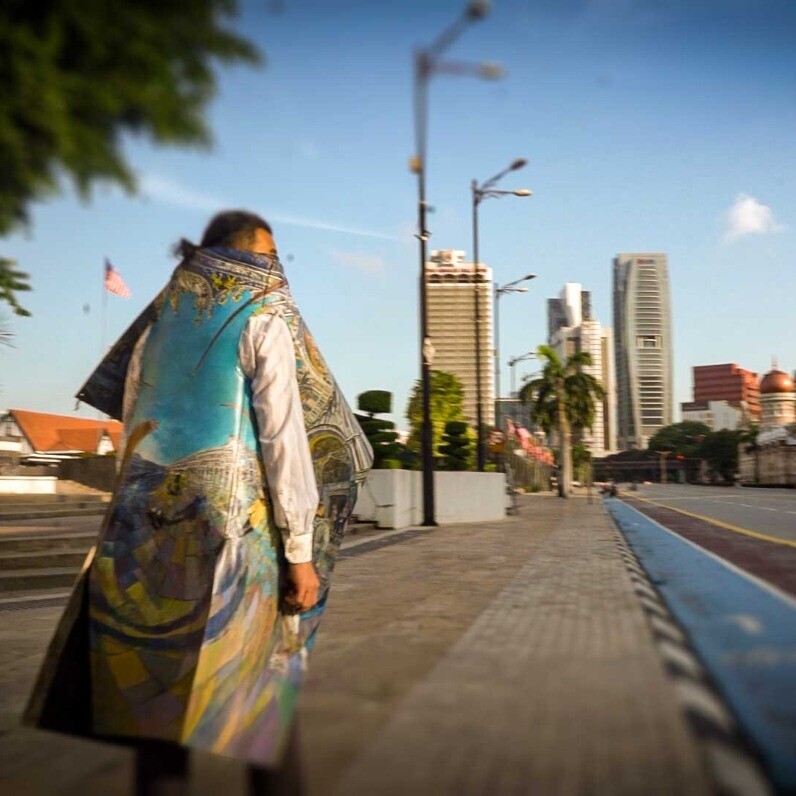
Ongoing and Upcoming art events
Influences
Education
Artist value certified
Achievements
Prizes and Awards
Collective Expositions
Permanent Collections
Residencies
Solo Expositions
Activity on ArtMajeur
Latest News
All the latest news from contemporary artist Chin Kong Yee
Published on Feb 12, 2013
Chin Kong Yee paints the streets and culture of Kuala Lumpur on canvas, with an added dramatic edge.
Press release
Press release
Current Exhibition:11 | 06 | to zweihundertzweiundsiebzigeinhalbstunden 04 | 08 | 06 and more Photography from Malaysia from the view of two differentiation of licher cultures of Chin Kong Yee and Volker W. Hamann. > Di-Fr 15-21 o'clock, SA 12-20 o'clock Gallery Tanner, Hauptstätter road 68, Tel. 0711/674 13 15
Expos Collective (Listing)
Exhibitions
2000
June 2000 `World in Square Feet’ Central Art Gallery, Kuala Lumpur
July 2000 `Colours of Brazil’ Isetan Gallery, Kuala Lumpur
Dec 2000 ` 3 Man Show’ Anugerah Gallery Star Hill Lobby, Kuala Lumpur
Nov 2000 `Philip Morris Group of Companies ASEAN Art Awards 2000 `
National Art Gallery, Kuala Lumpur
2001
June 2001 ` Locals Only! ` Gallerie Taksu, Kuala Lumpur
Oct 2001 ` Manusia ` N.N. Gallery Kuala Lumpur
2oo2
April 2002 `Identities Who we are`National Art Gallery,Kuala Lumpur
Oct 2002 'Figuring Splendour'Metro Fine Art,Kuala Lumpur
Expos Solo (Listing)
2003
April 2003, `Undulating Spaces’Townhouse Gallery,Kuala Lumpur
Article
Chin Kong Yee seeks his audience to feel and see what he has experienced in the creation of his art work. He has labeled his style as Actuality Accorded Painting (AAP), whereby, in painting and portraying an object, it has to have existed, and have undergone the process of being real, in order for it to be translated onto the canvas as Art. AAP, is basically the act of seeing-where the past, the present and the future is enveloped into one when one looks at an object. Once eye contact has been made through AAP, the images become the past. This can be seen in some of his cityscape works, namely Kull Mariyanan where “half of a moving taxi” gradually fades into the facade of a building.
The same theme is seen in his figurative works, where the model is painted over a period of a few hours, and thus never really stays in one position (movements and expressions however slight, are continually undulating). As the artist aptly says, ‘ / cannot subjectively decide how she looks, / can only portray her according to a combination of changing expressions, over a period of time... because the affinity between different individuals changes very subtly with every moment”.
To this artist, nothing is ever stagnant. Images are changing and evolving as you look at them. Space can never be measured or fixed, it is only present in the mobility of Time.
Kong Yee’s works evoke a some what surreal feel about them.By combining the present, past and future through a depiction of two perspectives (realistic and unrealistic) his paintings have an exciting, dramatic edge about them that draws the viewer into his space.
Article
Actuality According Painting (AAP), the portraying object it have to be realistically exist and had to undergo the quality of being real.
An existent reality without undergo the process of experiment and contact, that is not reality. It is merely a scheduled reality.
The AAP is a phenomenon of seeing, interlace by the contact and experience of subjectivity and objectivity world.
Seeing phenomenon means develop and making of the mark system in spatial and sight.
When seeing this system begin to operate and produce, marks being trace continuously, and because of difference it creates an initial image, and between these mark new images are being form continuously, they become the past once the contact has been make.
An absolute presence that is impossibility, images is situated endlessly in an uncertain circumstance, they can only reorganize and transform.
The actuality of spatial cannot be fixed, it just present in the mobility of time.
Article
2000 Philip Morris Group of Companies ASEAN Art Awards 2000
Honorable Mention
Article
Chin Kong Yee seeks his audience to feel and see what he has experienced in the creation of his art work. He has labeled his style as Actuality Accorded Painting (AAP), whereby, in painting and portraying an object, it has to have existed, and have undergone the process of being real, in order for it to be translated onto the canvas as Art. AAP, is basically the act of seeing-where the past, the present and the future is enveloped into one when one looks at an object. Once eye contact has been made through AAP, the images become the past. This can be seen in some of his cityscape works, namely Kull Mariyanan where “half of a moving taxi” gradually fades into the facade of a building.
The same theme is seen in his figurative works, where the model is painted over a period of a few hours, and thus never really stays in one position (movements and expressions however slight, are continually undulating). As the artist aptly says, ‘ / cannot subjectively decide how she looks, / can only portray her according to a combination of changing expressions, over a period of time... because the affinity between different individuals changes very subtly with every moment”.
To this artist, nothing is ever stagnant. Images are changing and evolving as you look at them. Space can never be measured or fixed, it is only present in the mobility of Time.
Kong Yee’s works evoke a some what surreal feel about them.By combining the present, past and future through a depiction of two perspectives (realistic and unrealistic) his paintings have an exciting, dramatic edge about them that draws the viewer into his space.
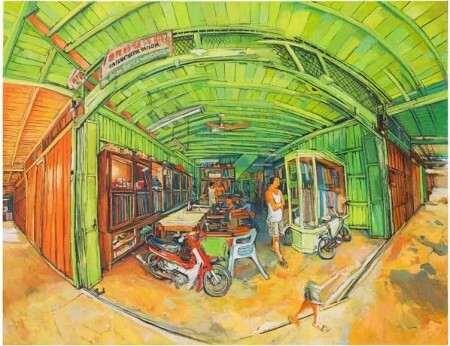
Article
Actuality According Painting (AAP), the portraying object it have to be realistically exist and had to undergo the quality of being real.
An existent reality without undergo the process of experiment and contact, that is not reality. It is merely a scheduled reality.
The AAP is a phenomenon of seeing, interlace by the contact and experience of subjectivity and objectivity world.
Seeing phenomenon means develop and making of the mark system in spatial and sight.
When seeing this system begin to operate and produce, marks being trace continuously, and because of difference it creates an initial image, and between these mark new images are being form continuously, they become the past once the contact has been make.
An absolute presence that is impossibility, images is situated endlessly in an uncertain circumstance, they can only reorganize and transform.
The actuality of spatial cannot be fixed, it just present in the mobility of time.
ART: Collected memories
In his latest exhibition, storyteller Chin Kong Yee reflects on life as he sees it, writes Sarah NH Vogeler
THERE is something about Chin Kong Yee’s works, which one immediately gets, in part, his vast canvases, which are impressive enough to warrant a great deal of attention. But more so, it is his abstract contemplation of Kuala Lumpur’s skyline ranging from the ever-bustling Brickfields to the indefatigable Petaling Street, of places we see often but think of little, feral, unyielding — Chin fixates on what’s exactly before him, and not upon the world to come.
“This is it,” he says outright, “it’s Ginsberg’s Howl, incomparable blind streets of shuddering cloud and lightning in the mind.”
Infinite Canvas, his latest exhibition at Wei Ling gallery, is a study done by a quiet spectator, each piece exquisitely finished and each scene intensely personal. There’s the solitary Chinese immigrant in one corner, the Indonesian worker anticipating the day’s end, the flower vendor consumed in his own activities, people milling about like apparitions from Lovecraft’s weird fiction.
My Father’s Noodle House is homage to Chin’s patriarch. The despair he felt after his father’s death in 2011 was an impossible weight and a terrible emptiness opened in him. Chin’s grief was absolute and for a time, he was inconsolable. “Life is terrifyingly subject to heartbreak and change, sunny and bright for a while, stormy and cruel the next. Very much like the city,” he reflects.
A day’s sojourn, observing the city spread out before him, Chin marvelled at how curiously “old” everything looked, fatigued and lonesome. It was as if she bared her soul for the taking and spared nothing for herself. Just like his father.
Chin painted his mother, uncles, cousins and friends, his father primed as a central figure, Chin’s valiant King.
Chin’s Raining echoes Gilbert’s “This rain, the blues gone grey, and the browns gone grey”, people running from both habit and impulse, others waiting for the rain to abate, with vague expressions and nervous energy. “It is remarkable how these variations in paces create a kind of harmony that lingers,” Chin muses. Raining is a splendid panorama of contrasts, a rich drapery of both the subtle and intense, of two cadences, which are strangely beautiful.
Jalan Cheng Lock and Kedai Kopi Li Fong was started in June 2011, but completed just before Infinite Canvas came to light. When asked why, Chin, quiet and introspective by nature, grew even quieter, which to the observer, is somewhat startling. “I stopped working on it after my father’s passing.”
As a student, this particular street was a frequent sight, one he crossed daily. For his mother, a restaurant within its folds was a regular haunt in her youth. He saw the painting with fresh eyes, the juxtaposed memories gifted a renewed vigour and Chin sought to illustrate just that — his mother’s perfumed recollections amid his own pedestrian observation.
Timeless is a study of fragmented emotions, of people going about their lives, the shifting of the hour, nerves on edge, jokes exchanged, the sun at its peak. Chin sees the city as both impersonal and personal, of mad and ruthless routine. Part of this artist’s charm lies in his innate ability to capture sentiments in an almost off-handed way. After all, Chin says: “Taking yourself too seriously is not always good.”
Bersih 3.0/ April 28 he says, is a representation of profound human emotions,of worry, trepidation, excitement, anticipation. Plus the colours before him, Chin was struck by the sea of yellows and greens against the grey of the pavements. “It had nothing to do with politics. It was an unbounded richness in hues that beguiled me. Beauty. That was what I saw. And that was what I painted.”
Jalan Tun H.S. Lee — Da Ma Cai — Indian Temple are paintings comprising two panels, which by deft alignment, results in 10 different images, Chin’s whimsical interpretation of the infinite. “In this instance, I believe that less is more and vice-versa. It’s really up to the audience.”
Wei Ling, who had represented Chin for a decade, recalls fondly: “When we first met, Chin was painting in his mother’s kitchen. It was an unforgettable sight — the woks and canvases. There was a slight, sticky situation with communication and we ended up speaking in Malay. We had his first solo in 2003 and now, 10 years later, his skills have developed stunningly, inspired in part by his extensive travels, and the gradual unearthing of his persona and accomplishments. There’s much to see and feel in his paintings — pleasure, contemplation, our own faces in them.”
An active member of the F Club, Chin along with artists Kow Leong Kiang, Shia Yih Ying, Kishore Sahoo, Noor Mahnun Mohamed, Maslin Ramly, Marvin Chan and Bayu Utomo Radjikin meet regularly for discourses, and delving into what they do best, painting.
“We’re a little like the Wednesday Art Group, (founded by Peter Harris in 1952, with members including Syed Ahmad Jamal and Jolly Koh), and exhibit regularly. Mostly figurative. The gratification of this pursuit is immense. We draw inspiration from each other.”
This is Chin Kong Yee, a soul delightfully turbulent, in a perpetual half-smiling, half-dreamy countenance and whom, given a choice between a piece of canvas and a plate of roti canai, would without batting an eye lid, pick the former.
He has come a long way since Undulating Spaces (his first solo), this admirer of Cezanne, Matisse and Pissarro.
“My first trip to Paris was incredibly serendipitous. There was a Cezanne and Pissarro exhibition. It changed me. It changed everything,” he says. Subsequent visits to Berlin, Romania and other parts of Europe opened him to a world more audible, one filled with romance, of splendour.
To see a world in a grain of sand, and a heaven in a wild flower, hold infinity in the palm of your hand and eternity in an hour, said Blake. And Chin is only at the beginning of his triumph, the road ahead pregnant with possibilities, blazing the way for masterpieces to unfold as he dives and rises to the highest altitudes.
Read more: ART: Collected memories - Sunday Life & Times - New Straits Times http://www.nst.com.my/life-times/sunday-life-times/art-collected-memories-1.211944#ixzz2Of3uq4ha
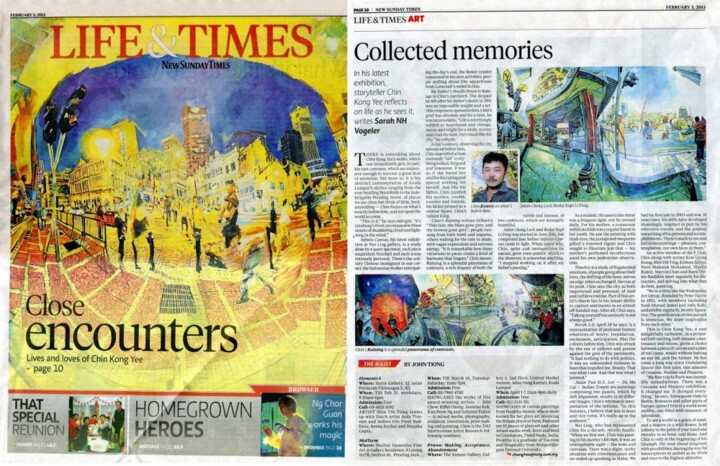
Expos Collective (Listing)
Feb 2017- 18@8 RIGHT HERE! RIGHT NOW!, Wei-Ling Contemporary, Kuala Lumpur, Malaysia
August 2016- Art Stage Jakarta 2016, Sheraton Grand Jakarta Gandaria City Hotel, Jakarta, Indonesia
April 2016- Art Beijing 2016, Agricultural Exhibition Centre of China,Beijing,China
April 2016- Young art Taipei 2016,Sheraton Grande Taipei,Taiwan
Jan 2016 - Art Stage Singapore 2016, Marina Bay Sands, Singapore
Dec 2015 - 18@8 Heirlooms, Wei-Ling Contemporary, Kuala Lumpur, Malaysia
Dec 2015-Art Kaohsiung 2015, THE PIER-2 ART CENTER, Kaohsiung, Taiwan
February 2015, Being Human: Figuratism of 16 Malaysian Artists,White Box, Kuala Lumpur
January 2015 , Being Human: Figuratism of 16 Malaysian Artists,The F klub,Atrstage Singapore 2015,Singapore
Sept 2014 Korean International Art Fair 2014 (KIAF) ,Seoul
Jun 2014-The Peak group show – ‘HO MIA’ ,Wei-Ling Contemporary,Kuala Lumpur.
Feb 2014-Flesh,The F Klub,Kuala Lumpur
Jan 2013-Seated,The F Klub ,Kuala Lumpur,Malaysia
Sept 2012-A decade of collecting,Timeless,Wei-ling gallery,Kuala Lumpur,Malaysia
Feb 2012-Skin,The Fklub,House of MATAHATI,Kuala Lumpur,Malaysia
Jan2011-Art Stage Singapore 2011,Singapore
Dec2010-Absolut 18@8, Wei-Ling Gallery, Kuala Lumpur, Malaysia
Feb 2010-Tiger Show, Wei-Ling Gallery, Kuala Lumpur, Malaysia
April 2008- China International Gallery Exposition 2008,Beijing,China .
April 2008- Mind Body & Soul - MBSIII,Wei-Ling Galery.Kuala Lumpur.
Nov2007- Annual 18@8 exhibition, Wei-Ling Galery.Kuala Lumpur.
April 2007- "EYE-llusions" Wei-Ling Galery.Kuala Lumpur.
Feb 2006 -1st ART Exhibition ,The MuGung Hwa Centre for Korean Culture & Art,Kuala Lumpur.
June 2006 -“zweihundertzweiundsiebziegeinhalbstunden und mehr “Galerie Tanner,Germany.
Nov 2006-“Mind Body and Soul II”, Wei-LingGallery.
Dec 2006-“ 18@8, Karachi, Pakistan”Amin Gulgee Gallery.
SEPT 2005 -“18@8” .Wei-LingGallery.
May 2004 -“East-westcontemporaries”,Cluj-napoca Art Museum,Romania.
DEC 2004 “SEOUL International Stars Exibition”,Seoul,Korea.
August 2003-“ Philip Morris Group of Companies Malaysia Art Awards 2003” ,National Art Gallery,Kuala Lumpur.
April 2002-“Identities Who we are” ,National Art Gallery,Kuala Lumpur.
Oct 2002 ”Figuring Splendour”,Metro Fine Art,Kuala Lumpur.
June 2001-“ Locals Only!”,Gallerie Taksu, Kuala Lumpur
Oct 2001 “Manusia “.N.N. Gallery, Kuala Lumpur.
June 2000 “World in Square Feet”, Central Art Gallery, Kuala Lumpur.
July 2000- “Colors of Brazil” Isetan Gallery, Kuala Lumpur.
Dec 2000-“3 Man Show” ,Anugerah Gallery Star Hill Lobby, Kuala Lumpur.
Nov 2000 -“Philip Morris Group of Companies ASEAN Art Awards 2000 “,National Art Gallery, Kuala Lumpur.
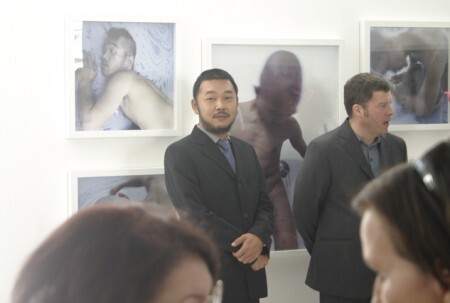
Expos Solo (Listing)
April 2003, -"Undulating Spaces"Townhouse Gallery,Kuala Lumpur.
June 2005 -"Cerulean Skies" Townhouse Gallery,Kuala Lumpur.
June 2007 -"SOS Château de Trémazan"Maison des Canons,France.
July 2009-“Reality In Wonderland”, Wei-Ling Gallery, Kuala Lumpur, Malaysia
july2010-new landscape, Wei-Ling Gallery, Kuala Lumpur, Malaysia
Jan 2013-Infinite Canvas,Wei-Ling Contemporary,Kuala Lumpur,Malaysia
August 2015_The flower,Weiling Gallery ,Kuala Lumpur,Malaysia.

Article
Awards
2000 Philip Morris Group of Companies ASEAN Art Awards 2000
Honorable Mention
Article
